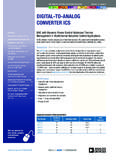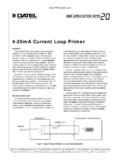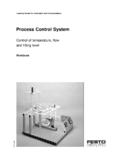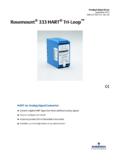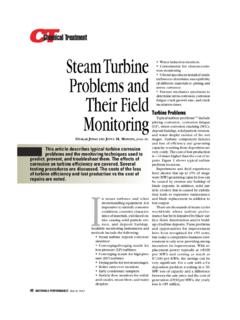Transcription of SEM1600 Topic 6: A Practical Introduction to …
1 6-1A Practical Introduction to digital power Supply control Laszlo Balogh ABSTRACT The quest for increased integration, more features, and added flexibility all under constant cost pressure continually motivates the exploration of new avenues in power management. An area gaining significant industry attention today is the application of digital technology to power supply control . This Topic attempts to clarify some of the mysteries of digital control for the practicing analog power supply designer. The benefits, limitations, and performance of the digital control concept will be reviewed. Special attention will be focused on the similarities and differences between analog and digital implementations of basic control functions.
2 Finally, several examples will highlight the contributions of digital control to switched-mode power supplies. I. Introduction power management is one of the most interdisciplinary areas of modern electronics, merging hard core analog circuit design with expertise from mechanical and RF engineering, safety and EMI, knowledge of materials, semiconductors and magnetic components. Understandably, power supply design is regarded as a pure analog field. But from the very early days, by the Introduction of relays and later the first rectifiers, power management is slowly incorporating more and more ideas from the digital world. Ones and zeros are translated to on and off s but at the end a diode can be viewed as a digital component.
3 The Introduction of switched mode power conversion required even more digital knowledge seeping into the repertoire of the practicing power supply designers. The know-how of the first discrete implementations of the PWM logic using comparators, gates and latches have faded away long time ago. Integrated pulse width modulator ICs have turned those simple digital circuits to history and have introduced even more digital content to power management. Today s highly integrated power management ICs are packed with digital gates. The digital circuits allow the integration of some highly sophisticated features. Some examples are EEPROM based trimming after packaging to eliminate package stress related initial offsets, digital delay techniques to adjust proper timing of gate drive signals, microcontrollers and state machines for battery charging and management, and the list could go on.
4 If power conversion already incorporates such a large amount of digital circuitry, it is a legitimate question to ask: what has changed? What is this buzz about digital power ? II. GOING digital Despite the tremendous amount of digital circuitry used in power management integrated circuits, it remained mainly hidden from the users. Most externally accessible functions are implemented by fundamentally analog circuit blocks today. Thus PWM controllers and other power management integrated circuits have successfully upheld their analog feel to them, making analog measurements and accepting analog controls. Their interfaces to the outside world are the various comparators and amplifiers monitoring the operating conditions and providing a choice of protection options for the designer of the power supply.
5 This elemental principle prevails in existing controllers as demonstrated in Fig. 1. 6-2 PowerStageFilterLOGICOUTCONTROLLERINSENS ORY INPUTS&COMMAND FUNCTIONSADC(PWM)VOLTAGE&CURRENTREGULATI ON Fig. 1. Top level analog PWM controller architecture. Another important aspect to notice in Fig. 1 is the fact that the analog inputs are converted to digital signals as soon as Practical . The point where the conversion is taking place in today s controllers varies depending on the signal type. When an under voltage lock out function is considered, the conversion is done by the simplest of all analog-to- digital converters, an UVLO comparator.
6 Its input is strictly analog, while the output is already a digital signal, it is either high ( 1 ) or low ( 0 ), with no intermediate value. But this digital output is also buried inside the integrated circuit and it is very rarely accessible by the designer. Output voltage and current regulation employs closed loop negative feedback, traditionally done by error amplifiers and the conversion to the digital domain is performed by a PWM comparator, again well concealed inside the IC. A. What Really is digital power ? digital power is an inaccurate description of a new direction in the controller design of the power supply to replace the analog circuits by digital implementations.
7 Accordingly, digital power really stands for digital control of the power supply. digital power supply control attempts to move the barrier between the analog and digital sections of the power supply right to the pins of the control IC. PowerStageFilterDIGITALPROCESSOROUTCONTR OLLERINSENSORY INPUTS&COMMAND FUNCTIONSADCVOLTAGE&CURRENTREGULATIONADC ADCADC Fig. 2. Top level representation of a digital power supply. This fundamental change in the control philosophy is summarized in Fig. 2. When comparing Fig. 1 and 2, it is important to emphasize that the deployment of digital control had no effect on the operating principle and the design of the power stage.
8 The specification of the power supply still determines the choice of topology, the selection of power components and the required control functions. That leaves a fair amount of design tasks still in the analog realm for the power supply expert. B. What is Changing? The striking difference between analog and digital control is the quality and the amount of information available for the controller to make decisions regarding the operation of the power stage. For example, the output of a comparator carries limited information about the monitored parameter, only whether it is above or below a threshold. When the border between analog and digital is moved from the output of a comparator to the input by converting the actual information to digital form, the controller suddenly knows the concrete value of the parameter.
9 Now, in addition to comparing it to a threshold, changes in the parameter s value can be detected, stored and later reported back to a supervisory system. If necessary, parameter values can be combined 6-3with other information in complex algorithms to perform even more sophisticated functions. Of course, this large amount of information can not be processed by traditional logic gates. digital controllers take advantage of large scale integration offered by state of the art semiconductor technology. Typically, a microcontroller ( C) or a digital signal processor (DSP) is at the heart of a suitable digital controller for power supply applications.
10 Another important controller property which changes significantly is the flexibility to implement various control algorithms. Traditional, analog controllers may employ sophisticated decision trees driven by the digital outputs of the various peripheral circuits. But the reactions to the changes in the operating conditions are pre-programmed and rigidly executed by the internal logic. For instance, the usual reaction to exceeding a current limit threshold is to shut down the converter and start over, hard coded into the logic of analog controllers. The power supply designer has no option and in most cases it requires a significant amount of external circuitry to circumvent some of the built-in features of the controllers.











